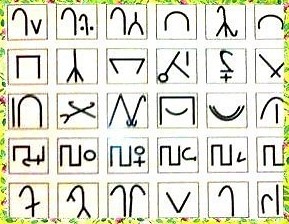"We find the Roman alphabet more convenient. It is also international. Most of intellectuals and literate citizens are used to it, and our imported equipment are described in Roman alphabet. Technically, we find its use more viable then any other script. For instance, we have an ancient Somali script which, if we were to get emotional, we would have adopted, but we did not, because we believe in reality. As a free people, we met without the so-called foreign experts, asked ourselves which script would best serve our modern needs, and decided on Roman alphabet. As you know, the use of this new alphabet is now a national fact."
https://books.google.iq/books?id=YQ...en&sa=X&ei=s7q4Udv2C-mF0QHJrYHoCA&redir_esc=y
The Writing of the Somali Language: A Great Landmark in Our Revolutionary History
By Wasaaradda Warfaafinta iyo Hanuuninta Dadweynaha
pages 1-3:
"An important point which is often lost sight of is that the ancient Somalis had evolved their own script systems which existed for a considerable period in their history. Convincing historical evidence in this respect is the numerous inscriptions and rockpaintings on cave-walls, on granite rocks, old coins etc., that are found to this day in various parts of the country. Some important sites where ancient inscriptions on cave-walls exist are reported as follows:
1. Godka Xararka in Las Anod District.
2. Qubiyaaley in Las Anod District.
3. Hilayo in Las Khoray District.
4. Karin Heeggane in Las Khoray District.
5. Dhalanle in Las Khoray District.
The most noteworthy of these inscriptions are undoub- edly those found on the mysterious «Taalo Tiiriyaad». These are huge stone mounds which are dotted about in northeastern Somalia and are a veritable archaeological riddle, since it is hard to tell when and for what purpose they were constructed. Noteworthy Taalo sites are in places such as:
1. Baar Madhere in Beledweyne District.
2. Xabaalo Ambiyad in Alula District.
3. Harti Yimid in Las Anod District.
Yet, these strange edifices must have had a definite purpose. Local opinion holds that they used to serve as altars or as sorts of religious monuments in the era when nature-worship was practised in the Land; still others consider that the Taalos mark ancient graveyards in which were buried important personages — chieftains, rulers, etc. together with their personal effects. In any case, these mute sentinels could, no doubt, tell much about the country's cultural and historical past and give us a glimpse into the life-story of by-gone ages. Although it is difficult to determine what caused the ancient Somalian system of writing to disappear altogether and how long it flourished, etc., there is no doubt that the encroachment of foreign cultures had greatly contributed to its final decline and disappearance. An interesting point, however, is that this script system was apparently based on vowel sound, not a Word-Picture writing as in ancient Egypt. As generations succeeded one another and people acquired better technical and scientific knowledge there were constant reforms and improvements called forth by the new social conditions of the age. This process might have been repeated over and over again in subsequent periods in the history of the land, until the very old forms of Somalian script finally died out and were completely forgotten by later generations."
http://dspace-roma3.caspur.it/bitst...eat landmark in our revolutionary history.pdf
https://books.google.iq/books?id=YQ...en&sa=X&ei=s7q4Udv2C-mF0QHJrYHoCA&redir_esc=y
The Writing of the Somali Language: A Great Landmark in Our Revolutionary History
By Wasaaradda Warfaafinta iyo Hanuuninta Dadweynaha
pages 1-3:
"An important point which is often lost sight of is that the ancient Somalis had evolved their own script systems which existed for a considerable period in their history. Convincing historical evidence in this respect is the numerous inscriptions and rockpaintings on cave-walls, on granite rocks, old coins etc., that are found to this day in various parts of the country. Some important sites where ancient inscriptions on cave-walls exist are reported as follows:
1. Godka Xararka in Las Anod District.
2. Qubiyaaley in Las Anod District.
3. Hilayo in Las Khoray District.
4. Karin Heeggane in Las Khoray District.
5. Dhalanle in Las Khoray District.
The most noteworthy of these inscriptions are undoub- edly those found on the mysterious «Taalo Tiiriyaad». These are huge stone mounds which are dotted about in northeastern Somalia and are a veritable archaeological riddle, since it is hard to tell when and for what purpose they were constructed. Noteworthy Taalo sites are in places such as:
1. Baar Madhere in Beledweyne District.
2. Xabaalo Ambiyad in Alula District.
3. Harti Yimid in Las Anod District.
Yet, these strange edifices must have had a definite purpose. Local opinion holds that they used to serve as altars or as sorts of religious monuments in the era when nature-worship was practised in the Land; still others consider that the Taalos mark ancient graveyards in which were buried important personages — chieftains, rulers, etc. together with their personal effects. In any case, these mute sentinels could, no doubt, tell much about the country's cultural and historical past and give us a glimpse into the life-story of by-gone ages. Although it is difficult to determine what caused the ancient Somalian system of writing to disappear altogether and how long it flourished, etc., there is no doubt that the encroachment of foreign cultures had greatly contributed to its final decline and disappearance. An interesting point, however, is that this script system was apparently based on vowel sound, not a Word-Picture writing as in ancient Egypt. As generations succeeded one another and people acquired better technical and scientific knowledge there were constant reforms and improvements called forth by the new social conditions of the age. This process might have been repeated over and over again in subsequent periods in the history of the land, until the very old forms of Somalian script finally died out and were completely forgotten by later generations."
http://dspace-roma3.caspur.it/bitst...eat landmark in our revolutionary history.pdf



